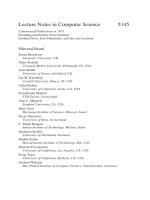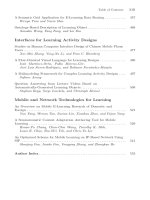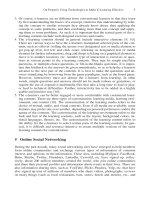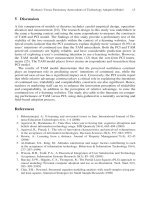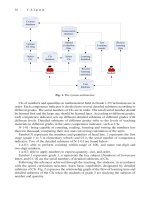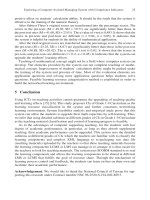Lecture Notes in Computer Science- P95 pptx
Bạn đang xem bản rút gọn của tài liệu. Xem và tải ngay bản đầy đủ của tài liệu tại đây (696.6 KB, 5 trang )
A Semantic Grid Application for E-Learning Data Sharing 459
The RDF structure is generic in the sense that it is based on the Directed Acyclic
Graph (DAG) model. RDF is based on the idea of identifying things using Web iden-
tifiers (called Uniform Resource Identifiers, or URIs), and describing resources in
terms of simple statements about the properties of resources. Each statement is a trip-
let consisting of a subject, a property and a property value (or object). For example,
the triple ("", ex:createdBy, "Wenya") has the meaning of
"mple has a creator and its value is Wenya".
RDF also provides a way to define classes of resources and properties. These
classes are used to build statements that assert facts about resources. While the gram-
mar for XML documents is defined by DTD or XSchema, RDF uses its own syntax
(RDF Schema or RDFS) of writing a schema for resources. RDFS is expressive and it
includes sub-class/super-class relationships as well as constraints on the statements.
The generic structure of RDF makes it easier for data interoperability and evolution
because different types of data can be represented using the common graph model,
and it also offers greater value for data integration over disparate web sources of in-
formation. OWL is an extension of RDF/RDFS and supports more sophisticated
knowledge representation and inference.
In our work, RDF is used to describe E-learning data semantics and define the E-
learning ontology in order to mediate heterogeneous databases.
2.1.2 OGSA/WSRF and the Globus Toolkit
OGSA/Web Service Resource Framework focuses on service-oriented architecture
for grid application. In a grid, computational resources, storage resources, networks,
programs, databases, and the like are all represented as services. A service-oriented
view allows us to address the need for a standard interface definition mechanism,
local/remote transparency, adaptation to local OS services, and uniform service
semantics.
The open source Globus Toolkit [20] is a fundamental technology for the "Grid". It
enables people to share computing power, databases, and other tools securely online
across corporate, institutional, and geographic boundaries without losing local auton-
omy. The toolkit includes software services and libraries for resource monitoring,
discovery, management, security and file management.
In our work, the E-learning services conform to the OGSA/WSRF specification,
and are implemented on top of Globus 4 toolkit. Globus 4 is also used as the service
container for the E-learning grid application.
2.2 Layered Architecture
Fig.1. illustrates the layered architecture of E-learning Semantic Grid.
At the basic service layer, three services are implemented.
1. E-learning Database Access Service. It supports the typical remote operations on
educational resource contents, such as course documents, videos, test-bases,
courseware, and teacher information etc. It also includes querying an education re-
sources, insertion an education resources, deletion an education resources, and
modification an education resources.
460 W. Tian and Y. Mao
2. E-learning Database Information Service. It supports inquiring about meta infor-
mation of the educational data resources such as DBMS descriptions, privilege in-
formation, statistics information that includes CPU utilization, available storage
space, active session number etc
3. E-learning Access Control Service. This service is developed for access control in
E-learning Semantic Grid. For example, it provides the service of authorizing or
authenticating students to access courseware resource.
Fig. 1. Layered Architecture of E-learning Semantic Grid
The services at the semantic level are mainly designed for RDF-based relational
schema mediation and semantic query processing.
1. E-learning Ontology Service. This service is used to expose the E-learning ontol-
ogy which is defined by RDF/OWL language. The ontology is used to mediate het-
erogeneous relational databases.
2. E-learning Semantic Registration Service. It establishes the mappings from source
relational schema to sharing RDF ontology. Semantic Registration Service main-
tains the mapping information and provides the service of registering and inquiring
about this information. For example, it provides the service that enables teacher
registering courseware and student inquiring about registration information of
courseware.
3. E-learning Semantic Query Service. This service accepts RDF semantic queries, uses
Semantic Registration Service to determine which databases are capable of providing
the answer, then rewrites the RDF queries according to relational schema. Namely,
the RDF queries will be ultimately converted into a set of SQL queries. The results of
SQL queries will be wrapped by RDF/OWL semantics and returned as RDF triples.
A Semantic Grid Application for E-Learning Data Sharing 461
3 The E-Learning Ontology
The E-Learning ontology is used not only to standardize the E-learning vocabularies,
but also as a shared model to mediate heterogeneous databases. The ontology is de-
veloped by using the Protégé ontology building toolkit. As Fig 2 displays, there are
two parts in the courseware ontology. One part is defined based on CELTS [18] or
IMS. The other part is defined as an extended set. The core set of CELTS has 11 ele-
ments as follows: Title, Subject, Keywords, Description, Identifier, Format, Date,
Language, Type, Creator and Audience. The definition and determinant of these ele-
ments see also CELTS40. The extended set involves general architecture information
class (FRAME) and page information class (PAGECONTENT).
Fig. 2. E-Learning Ontology
4 Working Scenarios and Semantic Tools
4.1 Typical Use Cases of E-Learning Semantic Grid
Generally, there are two kinds of user roles in E-learning Semantic Grid, they are:
Local Database Administrator (such as teachers), and Normal User (such as students).
Fig.3. illustrates the relationship between these user roles and the core components of
E-learning Semantic Grid.
Local Database Administrator (such as teachers). Education resources can be dy-
namically added into the sharing cycle of an e-learning semantic grid. E-learning
Semantic Grid provides the education resource provider (such as a teacher) with a
462 W. Tian and Y. Mao
Semantic Mapping Tool. After a database grid service is up, the teacher can use se-
mantic mapping tool to register his database to the semantic grid. Typically, the map-
ping tool retrieves the E-learning ontology from ontology service, and gets the rela-
tional schema from database grid service. Then the DBA can visually map the
relational schema to E-learning ontology. The following are the steps a teacher would
follow in order to register a courseware to the Semantic Registration Service:
1. Obtain the local database resource schema;
2. Obtain the domain ontology on the ontology service;
3. Establish the semantic relational mapping between the local database resource
schema and the sharing ontology;
4. Submit the registering information to the semantic registration service.
Fig. 3.Working Process of the E-learning Semantic Grid
Normal User (such as a student) for normal users, E-learning Semantic Grid of-
fers an intelligent user interface called Semantic Browser [8]. It is a visual interface
that enables the user to graphically browse the RDF/OWL semantics and visually
construct a RDF semantic query. The following is the process that a student inquires
about a courseware:
1. User browse the E-learning ontology by using the semantic browser;
2. User visually construct a semantic query;
3. User submit the query to a semantic query service;
4. The semantic query service accesses the Semantic Registration Service to query the
workable database resource and gets the schema mapping information;
5. The semantic query service generates the distributed SQL Query plan;
6. The semantic query service gets the data information from the idiographic data-
base;
7. Return the result to the student.
A Semantic Grid Application for E-Learning Data Sharing 463
4.2 Semantic Tools for E-Learning Semantic Grid
4.2.1 Semantic Browser
E-learning Semantic Grid offers a semantic browser [8] which enables users to inter-
actively specify a semantic query. Users can search education information in an E-
learning semantic grid. Although the information comes from all nodes, it is done
transparently to users. Users feel as if they are operating on the same database of the
same computer. This form-like query interface is intended to facilitate users in con-
structing semantic queries. The query form is automatically generated according to
class definitions. For example, a user wants to search courseware with subject as
“Java” from E-learning Semantic Grid. Fig.4 showcases how users can step-by-step
specify a semantic query to find out those needed courseware. In the first step (the left
part of the Fig.4.), the user selects the course class, and the query form for course
class will be generated automatically according to the property definitions of the
class. In the second step, the user inputs a constraint which specifies that the name of
the subject as "Java”. The Semantic Browser automatically constructs the semantic
query in SPARQL query language, the standard semantic query language proposed
by W3C. The semantic query will be submitted to the semantic query service, and
translated into a set of SQL queries to retrieve data from disparate data sources. The
query result will be automatically transformed back to the RDF format.
2.
A query interface is
automatically generated
according to the property
definitions of the selected classe.
User could select properties of
interest, and inputs query
constraints such as the name of
the disease.
Properties
1.
User selects
one class from
this ontology
tree
Fig. 4. E-Learning Semantic Browser
4.2.2 Semantic Registration
The task of defining semantic mapping from local relational schema to RDF ontology
is burdensome and erroneous. E-learning Semantic Grid offers a visual tool to facili-
tate the task of defining semantic mappings. As Fig.5 displays, the user can use the

